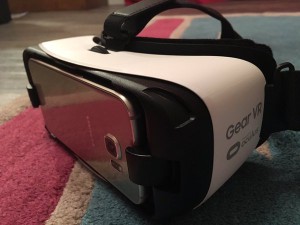by Sarah Jones
There’s lots of research out there about active learning. We all know the stats that after two weeks you remember 10% of what you read, 50% of what you see and hear but 90% of what you do. I like to reach 100% and by exploring and utilizing experiential active learning, I think we can get to that.
By experiential active learning, I am talking about immersion. To be more precise, I am talking about virtual reality and creating learning environments that draw on all those elements about experiencing a lesson and being active in another world. This is what I believe immersive technologies allow us to do.
I came to this technology as a storyteller. I was a television journalist before academic life and found that by creating 360 degree films and placing them within a virtual reality framework, I could get closer to a story and create more connection and understanding. Working at the university, it seems natural to then place this within the context of education and using those same drivers for connection and understanding to enhance education. It suddenly changes how we learn.
Imagine a classroom where a history teacher no longer has to show images of the Colosseum in Rome when taking pupils through a history lesson. Instead the pupil can reach for a headset and go their themselves.
In Geography classes, they can take a group field trip to experience volcanoes. They can see the rock formation and reach out to see how the lava is rising through the ground.
I took this technology to Boston, USA and the Media Education Summit in November 2015 and demonstrated this to a group of five school children between 14 and 16 years old. They all put on headsets. Some were in a circus flying through the trapeze with the Cirque du Soleil. Others were driving cars and trying their best not to crash as all first time drivers do. Others were in NASA. They were walking around the space shuttles. Getting so close they could reach out and touch the rockets in front of them. They all said “wow”.
I asked them to think about what it would be to like to be in a classroom and experiencing the subjects that they were learning about. Very simply they said “we would remember that lesson”.
With the Immersive Education project I am working on at the DMLL, we are taking these experiences further and making them active by applying a gaming platform. The student has to make choices in the experience. They have options which will tailor their learning. It is no longer just experiential but they are in control and determining their own learning experience, creating a personalized environment. Research shows learners perform better learning through games. They have 11% higher factual knowledge, 14% higher skills-based and retain the knowledge 9% more. Most importantly is that they work harder voluntarily.
Virtual Reality in education allows students the chance to experience environments that are crucial to their learning but that may be difficult to simulate. It’s an exciting field of study and one that is transitioning all the time as the technology develops and that is what makes the learning experience even more fun.
Join me on Twitter @VirtualSarahJ to engage in the conversation around 360 films, immersive storytelling, virtual reality and of course, immersive education.

When you spend all day writing a research paper on this, you have to end with a game or two #VR pic.twitter.com/esu8IlIXtR
— Sarah Jones (@VirtualSarahJ) February 26, 2016
